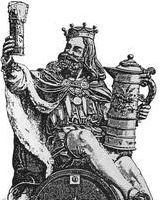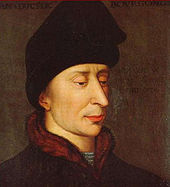Gambrinus
Gambrinus (/ɡæmˈbraɪnəs/ gam-BREE-nəs) is a legendary European culture hero celebrated as an icon of beer, brewing, joviality, and joie de vivre.Typical representations in the visual arts depict him as a rotund, bearded duke or king, holding a tankard or mug, and sometimes with a keg nearby.Although legend attributes to him no special powers to bless brews or to make crops grow, tellers of old tall tales are happy to adapt them to fit Gambrinus.[6] The 59th stanza of the English drinking ode "The Ex-ale-tation of Ale", written by Peter Mews, evidences a British appropriation of the myth: To the praise of Gambrivius, that good British kingThat devis'd for the nation by the Welshmen's taleSeventeen hundred years before Christ did springThe happy invention of a pot of good ale.According to Aventinus, Gambrivius is a seventh-generation descendant of the Biblical patriarch Noah.Tacitus alludes to an earlier source (Strabo) who lists tribes called the Gambrivii and the Marsi among the peoples descended from Tuisto:[11] the offspring or subjects of Gambrivius and Marsus, respectively.But Jean Tixier had only catalogued and reported a conjecture made in the name of the Hellenistic-era historian Berossus,[18] by the fraudster Annio da Viterbo (1498), who had previously used the same hypothesis to postulate an ancestry for the Gauls.[20] The myths also reimagined Gambrivius as a catalyst for the enlargement of the territory of a Germanic people (the Gambrivii), and made him a divine conduit into Germania for the Egyptians' ancient beer lore.One of the persons theorised to be the basis for the Gambrinus character is John I (c. 1252–1294)[21]: 3 of the Duchy of Brabant, which was a wealthy, beer-producing jurisdiction that encompassed Brussels among other cities.Even in the Middle Ages beer was an international commodity, and major brewing cities developed distinctive styles and reputations.He was age 20 or 21 in 1392, when Duke Albert I granted the Dutch cities of Haarlem and Gouda permission to brew beer with hops.With diabolical help, Cambrinus wins a fortune in games of skill and chance, becomes an irresistible player of the carillon, and becomes the first mortal to brew beer.Cambrinus' music and beer make him very famous, and eventually the king of the Netherlands heaps titles of nobility on him: Duke of Brabant, Count of Flanders, Lord of Fresnes.The play was first produced in the US town of Jackson, Michigan on 21 July 1875, by a blackface troupe called Duprez and Benedict's Minstrels.[35] In a very brief magazine piece, Deulin told a legend (possibly his own invention) in which Gambrinus and a host of ancient French (or, alternately, Franconian) kings gather each May Day for a midnight feast at a "Devil's table" (German: Teufelstisch) near Grafenberg, Germany.[36] Because of Gambrinus' significance, breweries, pubs, restaurants, shops, and malt houses have appropriated the character or his name for their brands.





Gambrinus (disambiguation)culture herobrewingjoie de vivrevisual artspatron sainttutelary deityArnold of Soissonstall talesfolklore motifstrial by ordealMarsusJohn the FearlessJohn I, Duke of BrabantJohannes AventinusGermanicOsirisWilliam IV, Duke of Bavariahistoriographertheft of fireFrancis BeaumontBiblical patriarchTacitusTuistoGermanic peoplesGermaniaStraboGambriviibroadsidescognatesJean Tixier de RavisiHellenistic-eraBerossusAnnio da ViterboFrancophoneGermanophonebroadside printsCharlemagneHenri LeysDuchy of BrabantmonographVictor CoremanscorruptionCounty of FlandersEarly NetherlandishDuke of BurgundyDuchy of Burgundytitles of nobilityCount of FlandersMiddle AgesDuke Albert IHaarlemorder of meritOrder of the HopŌrdō lupuliJean-Jacques ChiffletCambraiHamburgMedieval LatinOld FrenchContes d'un buveur de bièreCharles Deulindeal with the Devilshort storiesBeelzebubcarillonblackfaceminstrelburlesqueJackson, MichiganFranconianMay DayGermanFalstaffNew Orleansmalt housesPlzeňpale lagerGambrinusPilsner Urquell BreweryCruzcampoHeineken InternationalmascotLeonetto CappielloBasque CountrySantiago GrafGrupo Modelodark lagerKing Gambrinus, Legendary Patron of BrewingPabst Brewing Companypoint of interestMilwaukeeCantillonframboiselambicBattinMythological kingOrigin mythAmandusArnulf of MetzVeronus of LembeekCeres (mythology)DemeterDionysusNinkasiTurmair, Johann GeorgLexer, MatthiasAventinus, JohannesHornung, ErikHazlitt, William CarewBritish MuseumLediard, ThomasAlexander DunckerL'intermédiaire des chercheurs et curieuxCoremans, Victor Amédée Jacques MarieJackson, MichaelChifflet, Jean-JacquesLippincott's Monthly MagazineGreenwood PressStaff writerDumont, FrankAinsworth, William FrancisOliver, GarrettModelo Museum of Science and IndustrySmithsonian InstitutionBrasserie Cantillon Brouwerij